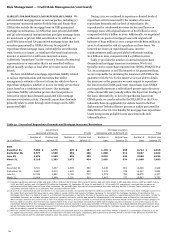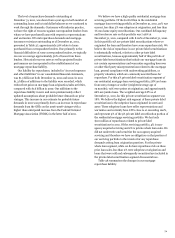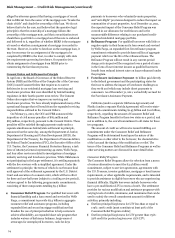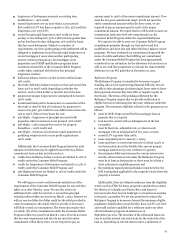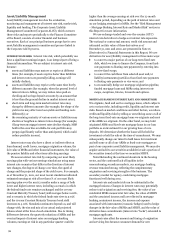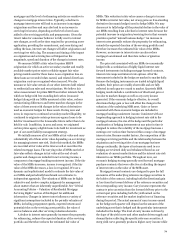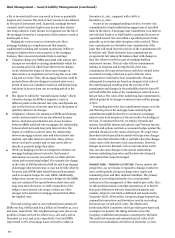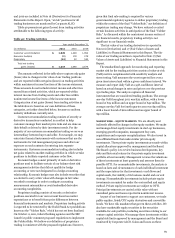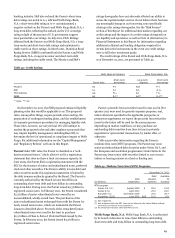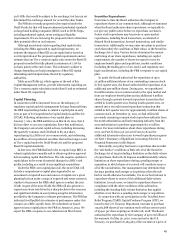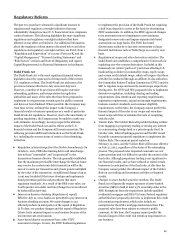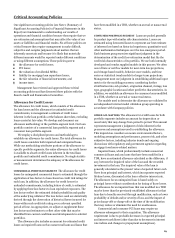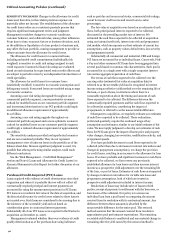Wells Fargo 2011 Annual Report Download - page 82
Download and view the complete annual report
Please find page 82 of the 2011 Wells Fargo annual report below. You can navigate through the pages in the report by either clicking on the pages listed below, or by using the keyword search tool below to find specific information within the annual report.
Risk Management – Asset/Liability Management (continued)
a flat or inverted yield curve can result in lower or potentially
negative carry income. The level of carry income is also affected
by the type of instrument used. In general, mortgage forward
contracts tend to produce higher carry income than interest
rate swap contracts. Carry income is recognized over the life of
the mortgage forward as a component of the contract’s mark to
market gain or loss.
Hedging the various sources of interest rate risk in
mortgage banking is a complex process that requires
sophisticated modeling and constant monitoring. While we
attempt to balance these various aspects of the mortgage
business, there are several potential risks to earnings:
Valuation changes for MSRs associated with interest rate
changes are recorded in earnings immediately within the
accounting period in which those interest rate changes
occur, whereas the impact of those same changes in
interest rates on origination and servicing fees occur with
a lag and over time. Thus, the mortgage business could be
protected from adverse changes in interest rates over a
period of time on a cumulative basis but still display large
variations in income from one accounting period to the
next.
The degree to which the “natural business hedge” offsets
valuation changes for MSRs is imperfect, varies at
different points in the interest rate cycle, and depends not
just on the direction of interest rates but on the pattern of
quarterly interest rate changes.
Origination volumes, the valuation of MSRs and hedging
results and associated costs are also affected by many
factors. Such factors include the mix of new business
between ARMs and fixed-rate mortgages, the relationship
between short-term and long-term interest rates, the
degree of volatility in interest rates, the relationship
between mortgage interest rates and other interest rate
markets, and other interest rate factors. Many of these
factors are hard to predict and we may not be able to
directly or perfectly hedge their effect.
While our hedging activities are designed to balance our
mortgage banking interest rate risks, the financial
instruments we use may not perfectly correlate with the
values and income being hedged. For example, the change
in the value of ARM production held for sale from changes
in mortgage interest rates may or may not be fully offset by
Treasury and LIBOR index-based financial instruments
used as economic hedges for such ARMs. Additionally,
hedge-carry income on our economic hedges for the MSRs
may not continue if the spread between short-term and
long-term rates decreases, we shift composition of the
hedge to more interest rate swaps, or there are other
changes in the market for mortgage forwards that affect
the implied carry.
The total carrying value of our residential and commercial
MSRs was $14.0 billion and $15.9 billion at December 31, 2011
and 2010, respectively. The weighted-average note rate on our
portfolio of loans serviced for others was 5.14% and 5.39% at
December 31, 2011 and 2010, respectively. Our total MSRs
represented 0.76% of mortgage loans serviced for others at
December 31, 2011, compared with 0.86% at
December 31, 2010.
As part of our mortgage banking activities, we enter into
commitments to fund residential mortgage loans at specified
times in the future. A mortgage loan commitment is an interest
rate lock that binds us to lend funds to a potential borrower at
a specified interest rate and within a specified period of time,
generally up to 60 days after inception of the rate lock. These
loan commitments are derivative loan commitments if the
loans that will result from the exercise of the commitments will
be held for sale. These derivative loan commitments are
recognized at fair value in the balance sheet with changes in
their fair values recorded as part of mortgage banking
noninterest income. The fair value of these commitments
include, at inception and during the life of the loan
commitment, the expected net future cash flows related to the
associated servicing of the loan as part of the fair value
measurement of derivative loan commitments. Changes
subsequent to inception are based on changes in fair value of
the underlying loan resulting from the exercise of the
commitment and changes in the probability that the loan will
not fund within the terms of the commitment, referred to as a
fall-out factor. The value of the underlying loan commitment is
affected primarily by changes in interest rates and the passage
of time.
Outstanding derivative loan commitments expose us to the
risk that the price of the mortgage loans underlying the
commitments might decline due to increases in mortgage
interest rates from inception of the rate lock to the funding of
the loan. To minimize this risk, we employ forwards and
options, Eurodollar futures and options, and Treasury futures,
forwards and options contracts as economic hedges against the
potential decreases in the values of the loans. We expect that
these derivative financial instruments will experience changes
in fair value that will either fully or partially offset the changes
in fair value of the derivative loan commitments. However,
changes in investor demand, such as concerns about credit
risk, can also cause changes in the spread relationships
between underlying loan value and the derivative financial
instruments that cannot be hedged.
MARKET RISK – TRADING ACTIVITIES
From a market risk
perspective, our net income is exposed to changes in interest
rates, credit spreads, foreign exchange rates, equity and
commodity prices and their implied volatilities. The primary
purpose of our trading businesses is to accommodate
customers in the management of their market price risks. Also,
we take positions based on market expectations or to benefit
from price differences between financial instruments and
markets, subject to risk limits established and monitored by
Corporate ALCO. All securities, foreign exchange transactions,
commodity transactions and derivatives used in our trading
businesses are carried at fair value. The Market and
Institutional Risk Committee, which provides governance and
oversight over market risk-taking activities across the
Company, establishes and monitors counterparty risk limits.
The credit risk amount and estimated net fair value of all
customer accommodation derivatives at December 31, 2011
80


